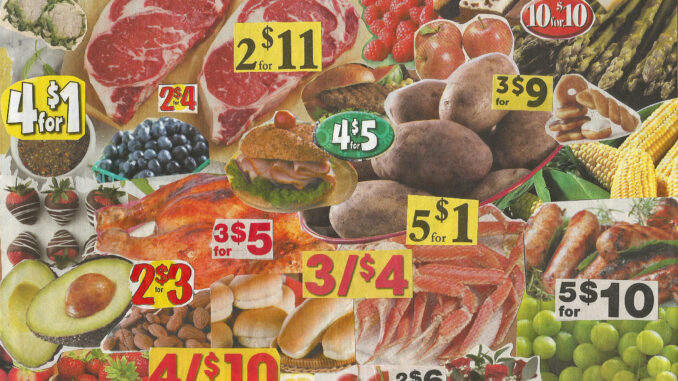
Tim Van Schmidt
I thought this was going to be easy.
I’m talking about getting a bead on just how much grocery prices have gone up in recent years.
You see, I have a habit of throwing newspapers and magazines into boxes and storing them — kind of like time capsules. Recently, while going through some of those boxes, I discovered that along with the newspapers I had saved, I had also saved a number of grocery store sale flyers.
Noticing this random resource, I began pulling them out of the stacks and came up with multiple grocery flyers from 2001, 2009, 2016, 2021, and 2022.
It occurred to me that analyzing these flyers — comparing prices on various products — could give a real-world view of how much grocery prices have changed over the course of 21 years.
So I sat down to work on one of those cold, below zero days in February to try to find comparable prices and products in these flyers and to set a timeline to what everybody knows has been a general increase in expense for the average grocery shopper.
That’s when my headaches began. These flyers were a jungle of information. My dreams of a crystal clear picture of grocery pricing were obscured by a bewildering number of products, brands, sizes, and weights often offered in ever-changing package deals.
Different stores had different prices on different brands in different seasons. It was mind-boggling.
After a while, I could only throw my hands up in the air and plead: “Help me Obi Wan Kenobi!”
It’s perhaps important to note that I was looking at sale prices exclusively. Everybody knows that sale prices are designed to get shoppers into the store so that regularly priced items — in themselves a confusing maze with varying prices depending on quantities and whether you have a shopper’s card or not — go in the basket right next to sale stuff. I’m not even going there.
However, some of the information I collected from these old flyers — perhaps the minimum you might pay for these items — did seem to offer some continuity, and here are some results:
Beef Ribeye Steak
2001 3.99 lb.
2009 6.99 lb.
2016 7.99 lb.
2022 8.97 lb.
7Up, Pepsi, Coca Cola, various 12 packs
2016 4X 10.88
2022 4X 11.88
Cheese
2009 2.99 lb.
2022 4.99 lb.
Bath Tissue 12 rolls
2009 4.99
2022 8.99
Oreos
2009 2.69
2016 2.99
2022 4.49
Real Mayonnaise
2009 2.77
2016 2.99
2022 4.49
Sockeye Salmon
2009 4.99 lb.
2022 10.99 lb.
Aluminum Foil 50-75 feet
2009 2.50
2022 2.99
Organic Eggs 12
2001 2.39
2009 2.99
2022 3.79
Chicken Boneless Breasts
2016 1.77 lb.
2022 3.69 lb.
Butter 8 oz.
2009 2.00
2022 2.99
Cereal 14 oz.
2016 1.49
2022 1.99
Pasta Sauce 15-24 oz.
2016 1.49
2022 1.79
Orange Juice
2009 3.00 64 oz.
2022 3.00 52 oz.
Ice Cream Quart
2001 2.50
2022 3.49
Pasta
2009 1.00
2022 2.00
Now, I’m aware that none of this is scientific and I’m sure that savvy grocery managers, as well as seasoned coupon/sale shoppers, could easily disagree with these price spreads. I mean, really, there are so many variables in play it’s nearly impossible to present a true head-to-head comparison, especially when the stuff is on sale.
Still, the general upward trend is there. And IF the above prices are at all accurate, then perhaps it’s possible to peer ahead and get an idea of what groceries might cost in the future.
For example, in 21 years, Beef Ribeye Steak increased by 125%. So, in 21 years from 2022 — 2043 — will it cost $20.18 lb.? In 13 years, Real Mayonnaise increased 62%, so in 2035 will it be $7.27? What about something really important like Oreo cookies? In 13 years, Oreos increased 67%, so will they cost $7.49 in 2035?
Shocking. You’d better start saving now for your grocery shopping trips in 20 years!
I’m sure that the grocery business is complicated and competition is intense. Add in supply chain problems, virus concerns, and consumer buying trends and you have a system as complicated as Einstein’s various theories.
But then we, as consumers, get to try to figure it out on our own, trying to make our dollars stretch further.
Are the above numbers meaningless? Probably. But today’s prices are not meaningless — not to our wallets.
Tim Van Schmidt is a writer and photographer based in Fort Collins. Find his YouTube channel at “Time Capsules by Tim Van Schmidt.”
Support Northern Colorado Journalism
Show your support for North Forty News by helping us produce more content. It's a kind and simple gesture that will help us continue to bring more content to you.
BONUS - Donors get a link in their receipt to sign up for our once-per-week instant text messaging alert. Get your e-copy of North Forty News the moment it is released!
Click to Donate
